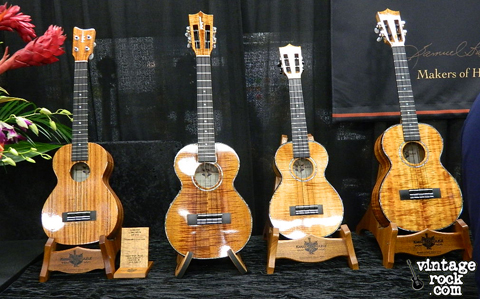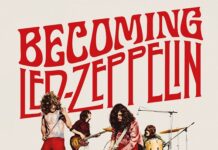By Bill Loconto
As a novice to the NAMM Show, and not knowing what to expect, my first reality was waiting in a single file line of cars on West Avenue hoping to find a place to park. Some 100,000 attendees were expected. I managed to secure a tight parking space on the back underbelly of the convention center seldom seen by most attendees. Lot 7, Hooray! I wasn’t quite sure if I should have packed a sack lunch as it took about 20-25 minutes to walk by pallets of storage crates and more convenient convention parking before reaching the check-in booth. It was akin to walking the back lot of a film studio. At least I had a chance to work on my tan. Sorry snowbound Easterners — the sun was shining with temperatures in the mid 70s.
At the check-in booth I was greeted by courteous and helpful event staff plus a decibel level only second to that of a shuttle rocket launch. I was also greeted by an unscripted combination of bass guitar riffs, trumpets, violins, drums and, of course, cymbals to round out the welcome. Discounting the slight inconveniences and walking alongside a sea of humanity from booth to booth, there was an uplifting energy of excitement, like children opening presents on Christmas Day. But make no mistake about it — NAMM is a candy store of treats for musicians of all ages.

UKULELES (ooo-ku-lay-lay)
While all the other VintageRock.com staff members were interviewing and filming vendors and artists, I took time to visit many of the ukulele booths in Halls D & E. I purchased my first ukulele at a street fair in Kona, Hawaii for $175 including the case. Having played some guitar in my earlier years, the transition to the ukulele was rather smooth because of familiar chord formations. Also, the ukulele has two less strings to deal with — how special is that?
I couldn’t be a closet ukulele player for the rest of my life, so I ventured out to find likeminded strummers and a group setting. In a short period of time, I was strumming with a group on Thursday mornings for two hours in Mission Viejo, then again on Wednesday mornings in Laguna Beach, building my repertoire of songs from the 1920s to the 1950s. As I gained confidence in my playing ability, I heard about a group in Huntington Beach playing Hawaiian music. I thought to myself, ‘How hard can this be? I know “Tiny Bubbles”.’ I walked into the Island Bazaar music store where a four-piece band was setting up and was welcomed by about 60 people tuning their ukes. Little did I know that it was literally “Hawaiian” music, mostly sung in Hawaiian. After that humbling experience I found out that you can find a local group of Ukulele players to strum along with seven days a week with periodic ukulele festivals locally, nationally and internationally.
When the subject of playing the ukulele comes up, depending on the age group and quite possibly the 2015 NAMM Show, there are immediate visions of raccoon coats, Rudy Vallee, George Formby, hula dancers, Arthur Godfrey saying “Hawaya, Hawaya, Hawaya” or Tiny Tim. However, most folks have not acquainted themselves with more recent talents such as Jake Shimabukuro, Daniel Ho, James Hill, or the Ukulele Orchestra of Great Britain.

A Brief Ukulele Backgrounder
It is said the ukulele made its way to the Hawaiian (Honolulu) shores on the afternoon of August 23, 1879, aboard the Ravenscrag carrying 419 Portuguese immigrants from Madeira, Portugal. The instrument at that time was known as a braguinha (a small guitar-like instrument, often called a machete) which had a slightly different string configuration but a close relative to the modern uke. There are many accounts of how the ukulele received its name. The story of Joao Fernandes borrowing his friend’s braguinha and playing for local Hawaiians on the dock upon arrival is my favorite. The Hawaiians were intrigued by the way Joao’s fingers melodically moved and played various notes; they called the instrument a ukulele or “jumping flea”.
The ukulele was first popularized when introduced by several musical groups from the territory of Hawaii (not yet a state) during the 1915 Panama Pacific International Exposition held in San Francisco, CA. The exhibition started the first ukulele craze that carried through the 1920’s and into the depression. Companies such as Regal, Harmony and Martin had mainland production facilities. Also, the notable Kamaka (Hawaiian) Ukulele was started in 1916 by Samuel Kamaka in the basement of his Kaimuki (Oahu), Hawaii home.
The next resurgence of ukulele madness started in the 1950s and 1960s. Much of the instrument’s popularity is attributed to Arthur Godfrey who was inducted into the Ukulele Hall of Fame in 2001. I’m also guessing that the increasing number of televisions in the 1950s, coupled with Godfrey’s TV show, helped to promote the uke. I also have to give a quick acknowledgement to Tiny Tim (aka Herbert Khaury) and his falsetto voice. He made several appearances in the late 60s on The Tonight Show and Laugh-In singing “Tiptoe Through The Tulips,” sporting a soprano ukulele. This was about the time the ukulele began losing its shine.

Roaring 1990s To The Present
The popularity of the ukulele waned after the 1960s. However, interest slowly re-emerged in the 1990s and has steadily increased year after year. Hawaii’s Israel Kamakawiwo’ole’s medley of “Over the Rainbow” and “What a Wonderful World” was an immediate success that appeared in several forms of media. Jake Shimabukuro has been wowing crowds with his high energy and virtuosity. The Ukulele Orchestra of Great Britain, a group of eight members (six men and two women), have been performing for approximately 30 years. They may play an occasional classical tune, or tackle something from another genre, like “The Ballad of Jed Clampett” and the Talking Heads’ “Psycho Killer.”
All ages are beginning to play the ukulele primarily because it’s easy to learn and strum. The Internet and YouTube has endless tutorials and videos covering numerous ukulele topics. Community centers around the country are offering ukulele classes to seniors which bring back many tunes from the early 20th century. It is not uncommon to hear groups strumming and singing “Ain’t Misbehavin”, “Five Foot Two” and “Honolulu Baby”.

The Ukulele at NAMM
While walking past numerous rows of ukulele exhibitors at NAMM, my first impression was to notice the similarity in appearance of the ukuleles in various booths. There were varying decorative patterns, bright colors and traditional wood ukuleles hanging on display walls from different manufacturers and distributors. Most of these instruments are produced in the Pacific Asian market. Because of the relatively low cost, the ukuleles are primarily targeted for the beginner. They consist of laminated wood models or various hardwoods or a combination of both. There are also plastic traveling ukuleles supplied by Bugsgear having a retail price of +-$70 for a soprano model.
In Orange County, CA, brick and mortar music stores carry recognizable brands such as Kala, Lanikai and Ohana, while Oscar Schmidt, Cordoba and Luna are also on the scene. When speaking specifically about Kala, Lanikai and Ohana, I originally pictured them in a market appealing to the beginning to intermediate ukulele player purchasing in the $100 – 500 range. To my surprise, Kala is now introducing their Elite model line to be produced in Petaluma, CA. Additionally, Lanikai is planning a Hawaiian made series. Because of the competitive market, many of these companies appear to be vertically integrating upward, offering upgraded models manufactured in Hawaii or on the mainland. By offering models for the beginner to the advanced ukulele player, there may be expectations of brand loyalty as a strategy going forward.
Conversely, on the opposite end of the market, are well crafted instruments which I call the “K” family of Hawaiian ukuleles — KoAloha, Kamaka, Kanile`a and Ko’olau. These ukuleles are made in Hawaii, typically of Hawaiian Koa the standard bearer of woods for the ukulele. Although some of these makers have soprano and concert size ukuleles for slightly less than $1,000 retail, be prepared to spend more than that. For the serious ukulele player, any of these brands will not disappoint.

KoAloha, Kanile’a and Ko’olau have additional brands known as Opio, Islander and Pono respectively selling for less than their Hawaiian made counterparts. These are manufactured in various Pacific Asian countries and are built to the manufacturer’s specifications. For example, a KoAloha representative indicated they “partnered with a factory in Thailand and did everything from the set-up to training them in the build procedure. They (ukuleles) are made of sapele (African Hardwood). Other than being foreign made with a different wood, they are 99% similar to a Hawaiian made KoAloha.” Depending on the brand, these ukuleles, in my opinion, are designed for the beginner to the intermediate player — someone stepping up in quality without paying the Hawaiian made price tag. So it appears, for the “K” family of ukuleles, there is a vertical integration of product lines in reverse.
What about lesser known companies competing for market share? I singled out two companies which I thought had different approaches to producing ukuleles. The first is Big Island Ukuleles located in Honolulu, HA. Big Island has a big brother brand marketed under the name Imua, which is Hawaii made. I can speak from personal experience about Big Island because I previously owned a Tenor Cutaway with a Fishman pickup. It was later sold to help finance my KoAloha Tenor. I admit I made a mistake and should have kept the Big Island in addition to purchasing the KoAloha, an exceptional instrument.
Big Island harvests, cuts and mills the Koa wood on the Big Island of Hawaii. The wood is shipped overseas to Vietnam where the ukuleles are manufactured into a quality instrument. From the model I previously owned, and the show samples viewed, there is definitely attention given to detail. Although your wallet will be a little lighter after purchase, the price will be less than a Hawaiian built koa instrument.

The last company I’ll mention is new to the ukulele world: Na Leo Ukulele. Located in Honolulu, Na Leo, in similar fashion, is sourcing its koa from Hawaii and creating two new brands. The Hawaiian Na Leo ukulele, which has yet to be priced, will be manufactured in Hawaii and made of solid Hawaiian Koa. The Kumu model (koa laminate) is manufactured in China. Jenny Liu, of Na Leo, indicated that the manufacturing facility in China is company owned thereby maintaining its quality control over production. Retail pricing for the Kumu is also unclear.
Keep Strummin’
After two years around the ukulele scene, I found that many players become infected with a disease commonly known as “UAS”. The disease is difficult to overcome and there is no known medical cure, but its full name is Ukulele Acquisition Syndrome. Once bitten by the ukulele (jumping flea) bug, there is an uncontrollable urge to purchase different varieties of ukuleles. After what I saw at NAMM, I found the only way to control UAS is through group intervention therapy, strumming as often as possible with as many Ukulele players as you can find. On that note, with no pun intended, start strummin’ or keep on strummin’ the uke. It’s good for the soul.





















